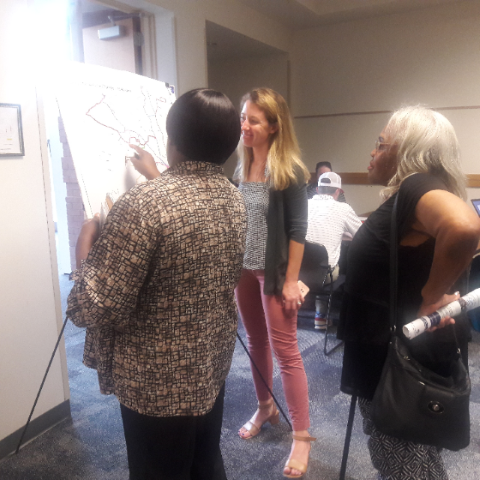CATS plans to straighten out meandering bus routes this fall
If you’ve avoided riding the bus to work because your travel time would be too long, relief is on the way! On October 1, the second phase of CATS’ Envision My Ride initiative will bring major changes to numerous bus routes to speed up your trip. By removing the numerous meanders that routes take into neighborhoods and instead keeping them traveling along major streets, CATS’s updated routes will allow many of its riders on the most popular routes to travel between more quickly.
CATS is proposing changes to almost 20 bus routes this fall including 1, 2, 6, 7, 8, 10, 16, 20, 21, 25, 30, 34, 45x, 60x, 61x, 62x, & 235.

CATS staff discuss proposed bus route changes with residents during public meetings.
CATS recognizes four standards that define a good bus route:
- Density: Are jobs, housing, and activities within a reasonable distance of each potential bus stop?
- Linearity: Does the bus routing run in relatively straight lines?
- Walkability: Are people able to easily walk to and from the bus stop to access activities?
- Proximity: Are bus stops and their respective destinations closely spaced?
The changes that will occur on October 1st will primarily address the second standard, linearity. Many CATS bus routes have remained relatively changed for decades. But ongoing shifts in locations and density of jobs, housing, and other amenities demand that the transit network adjust to meet the needs of riders.
How does a rider’s experience improve when the “wiggles” are taken out of a route?
- Faster trip time: It will take less time to travel between any two points on a route.
- Greater reach of destinations: Bus routes can be extended beyond their previous end points (when it makes sense to do so).
In a previous article, we covered the trade-offs between linearity and coverage. In addition to these revised bus routes, CATS will maintain — and make some adjustments to — less frequent neighborhood and community services.
Will it work?
It already has! After CATS straightened the #4 Belmont route and connected it to light rail immediately following the opening of the LYNX Blue Line Extension in March 2018, ridership has already increased by 9 percent.
But more change is needed. Most of the routes that will be changed on October 1 still won’t run every 15 minutes or less. Transit Center’s Who’s On Board 2016 report identified that high frequency is one of the most important elements of great transit. To run buses more frequently, CATS will need to add more overall service hours to its schedules. That will mean hiring more drivers, buying more vehicles, and maintaining those vehicles.
The good news is that there’s plenty of evidence from across the country that well-planned bus network redesigns work. Even with the rise of telecommuting and ride-share services, mass transit simply remains the most cost-effective and equitable way to move people in densely populated areas.
CATS staff will be available to discuss the bus network redesign during their second round of public meetings this summer:
Cornelius Town Hall
July 19 (6:00 p.m. – 7:30 p.m.)
21445 Catawba Ave, Cornelius, NC 28031
Davidson Town Hall
July 31 (6:00 p.m. – 7:30 p.m.)
216 South Main Street, Davidson, NC 28036
CharMeck Library (Uptown)
August 1 – (11:00 a.m. – 1:00 p.m.)
310 N Tryon St, Charlotte, NC 28202
Francis Auditorium
*Drop-in information session
Charlotte Mecklenburg Fire Department Headquarters
August 2 (6:00 p.m. – 7:30 p.m.)
500 Dalton Avenue, Charlotte, NC 28206
Huntersville National Night Out
August 7
Charles Mack Citizen Center
August 9 (6:00 – 7:30 p.m.)
215 N Main St, Mooresville, NC 28115
Huntersville Recreation Center
August 16 (6:30 p.m. – 8:00 p.m.)
11836 Verhoeff Drive, Huntersville, NC 28078
Thanks for reading!
As a nonprofit, community support is essential for us to keep doing what we do — including providing free articles like this. If you found this article helpful, please consider supporting Sustain Charlotte.
Want to stay in the loop? Subscribe to our weekly newsletter and follow us on Instagram, Facebook, and Twitter.
